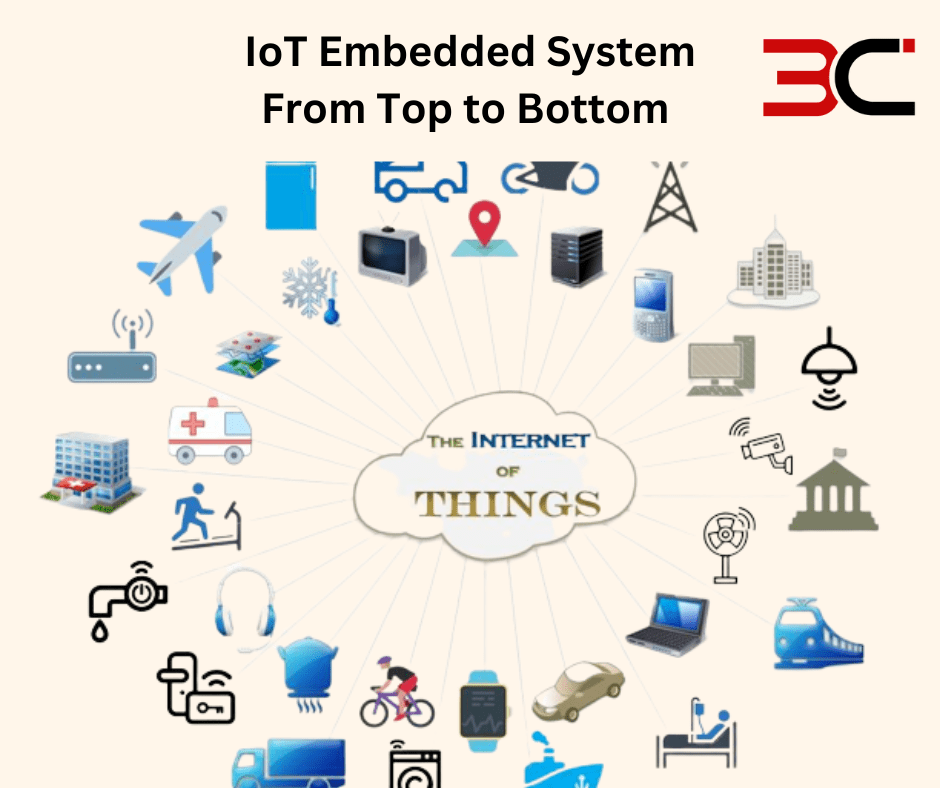IoT devices frequently use embedded systems. Microprocessors and microcontrollers are used in conjunction with software in unique IoT systems to allow networked devices to interact.
The IoT era did not begin with embedded systems. By the 1970s, microcontrollers and integrated circuits were widely used in electronics. IoT devices only exist now due to the existence of embedded systems that were created with a specific goal in mind.
In this article, we will examine embedded systems for the Internet of Things (IoT) devices in-depth, including the definition of IoT, embedded systems, the benefits in business, and so on.
The Definition of IoT
IoT, which stands for “Internet of Things,” describes how linked the gadgets we use on a daily basis are. To make daily work easier, “smart” electronics of today may link to the internet, sensors, and other devices. For instance, a smart fridge can identify the contents and the expiration dates and tell the owner of them. This is a typical application of IoT in daily life.
The Definition of Embedded Systems
An embedded system is a small computer that was created specifically for a given task. A microcontroller or microprocessor, an integrated circuit that primarily houses a CPU, memory, and I/O (input/output) peripherals solely on a single chip, is frequently found in such computers. Embedded systems frequently have sensors that enable ambient conditions to be monitored.
An embedded system is one that is capable of performing some sort of digital signal processing. This sets it apart from simple hardware gadgets, which merely include circuitry and sometimes a battery.
Many of the microcontrollers powering IoT devices were designed by ARM, which defined embedded systems in the following way:
- “IoT devices are physical components that can transfer data over the internet or other networks and are designed for specific purposes.”
How the Industry is Utilizing IoT
Embedded systems are independent technologies that are often made to perform a single task. An embedded system can be connected to the Internet and can interact with other embedded systems that are part of the Internet of Things, which is known as an IoT system.
There are embedded IoT systems everywhere around us, including:
- Set-top boxes
- Parking meters
- Point-of-Sale (POS) terminals
- Any “smart” devices such as smart refrigerators, fitness trackers, smart bicycles, etc.
- A wide variety of medical devices
- end so on
- Industrial Internet of Things (IIoT)
IoT might be considered the start of a fourth industrial revolution, or “Industry 4.0.” Although the influence of IoT on personal devices is well known, there have been significant developments in the industrial sector.
By boosting connectivity and accessibility, Industry 4.0 can help bring IoT solutions to a larger industrial scale. It will be enormous when the potential influence of the IIoT merges with developing technologies (i.e., AI in international manufacturing) and industrial systems.
- Internet of Medical Things (IoMT)
Since more businesses are attempting to convert everything online, from diagnostic gadgets to hospital equipment, there has been a constant adoption of IoT in the medical industry. IoMT is beginning to alter how we see medical technology and patient care.
The demand for medical devices has grown as a result of the demand for remote and realistic solutions. The medical industry, which is sometimes referred to as “IoMT,” contains its potential and hazards for connecting medical services to the web.
- Bringing IoT to Life
Despite the fact that IoT-based solutions are intriguing, uploading device data to the cloud is challenging. Determining the ideal connectivity for the solution requires a lot of work. Knowing how IoT will affect a current product or the specifications for a new one. This is where embedded systems start to function.
The Advantages of IoT in Business
It is time to learn about some great capabilities that end users may take advantage of while utilizing an IoT product, especially from a monitoring and reporting viewpoint, now that we have a better understanding of what IoT and embedded systems are.
But there are also commercial advantages for product designers who design with connectivity in mind:
- Firmware upgrades that can be performed remotely without user input. Compared to non-connected items, which have much more difficult update processes or may not be possible to update at all. Moreover, it will require significantly less user input for over-the-air upgrades.
- Managing licenses in order to safeguard your intellectual property. This makes it more difficult for a customer to steal your product by readily reverse engineering the program to remove the program that gives it its unique selling point.
- Gathering uses data for more product study and development. Usability testing for embedded systems has to be carried out totally in person before IoT gadgets become a reality.
- Nowadays, usage data is collected remotely to determine which features are utilized and how frequently they are used. With this data, changes and new product versions are driven by actual user demands and use cases.
The Value of Embedded Systems in the Internet of Things (IoT)
The IoT ecosystem’s basis is mostly built on embedded systems. Without embedded systems, many IoT components wouldn’t be possible. This is the significant importance of an embedded system in the IoT.
Although the internet is necessary for data transmission between IoT devices via online (cloud) services, embedded systems are what allow for the sending and frequently local interpretation of this data.
The information embedded systems analyze might originate from local computers, cloud storage, or mobile apps. The multitude of sensors, however, continuously input actual information, which is the most important source of information. The decision to send this data over any available IoT device connectivity will thereafter be made by embedded systems.
Challenges with Integrated IoT Software
When developing software for an IoT product, some of the challenges become much more prominent. The following three issues exist with IoT-embedded software development:
Security
The security of the device is arguably the greatest and most significant difficulty in developing an IoT product. Although the hardware choices may allow devices to communicate present a significant portion of the difficulty, security threats are also mitigated by software.
Devices that are linked to a vast network have higher attack permeability than those that are not. What size is this problem? According to research by Nokia from its device observation,
- The endpoint security software detected 32.72% of malware attacks in 2020 via IoT devices (source).
A hacked IoT-enabled gadget might result in fatalities. When security for IoT in IoMT, IIoT, and automotive is not taken into account, there is a significant danger. The worst-case situation will be this.
Upgrades
The key feature of an IoT system is its connection, which enables over-the-air upgrades for embedded software and apps on any connected cell phone or online services. An upgraded IoT device must be able to perform the followings –
- To ensure nothing fails on the device or its program, thoroughly test the upgrades.
- Offering rollbacks or halting updates if problems are discovered after deployment
- Working within the hardware and networking constraints of the device.
- Efficiently and successfully producing timely updates.
- Doing usability testing prior to implementation.
- Recognizing when upgrades are required.
Low Memory
Generally, embedded systems lack the large quantities of memory and computing power of a personal computer. These hardware constraints require embedded software to be as effective and compact as feasible.
Each feature and each line of code must perform a specific function. Gigabytes of memory won’t be immediately accessible to an embedded device.
IoT Embedded System Types
Any kind of software must be put on an embedded system for the Internet of Things (IoT) in order to work properly. It can only be firmware, or it might be an embedded system. The software enables a specific IoT-embedded system to interact with other IoT-embedded system components.
A single-purpose device is another name for an embedded system. These devices are Internet of Things (IoT) embedded systems designed exclusively to run a single piece of software or carry out a task unique to a particular industry.
Here are some examples of IoT embedded systems with a single use –
- POS Solutions
- Kiosk devices
- Self-checkout systems
In many different industries, including retail, consumer goods, automotive, medical, and many more, embedded systems are extensively employed.
IoT vs. Embedded Systems
Let’s take a look at the following table to know the difference between IoT and embedded systems,
| Topic | IoT | Embedded systems |
| Connectivity | Every embedded IoT system does. | Internet access is not required for an embedded system. |
| IoT is not a subset. In fact, it may have subsets. | One subset of the IoT may be the embedded system. | |
| Amount/range in real-life | Embedded IoT solutions often cover a wider range. | Relatively less than IoT-based systems. |
| Multi-use | After the gadget has connectivity and communication capabilities may be used in several situations. | The internal complexity of embedded systems. Basically, designed for a single purpose. |
| Example | Smart refrigerators or smart fire alarms. | Refrigerators or microwave ovens |
Devices with Embedded Systems that are Not Part of the IoT
IoT-embedded system development has gotten a lot easier. The devices listed below have not traditionally been employed in IoT-embedded systems:
- Microwave ovens
- Washing machines
- Machine tools
- Industrial robots
On the other hand, modern warehouse robots are increasingly frequently built as IoT-embedded systems that can link to the central panel through the internet and be controlled using MDM services.
Choosing an embedded IoT system enables the device to get IoT OTA updates even if it is that specific item that needs to be online, provided the appropriate computer program has been loaded, and the necessary infrastructure is provided.
Button Line
Whether it is managing the supply chain with RFID assistance or tailoring medical equipment with IoMT, IoT offers a ton of promise in a range of business scenarios. And an integral component of these developments will continue to be embedded software design for the IoT.
IoT technology is continually evolving. As more industries recognize the potential for linked devices to improve the way they conduct business significantlyWhat IoT Embedded Systems: From Top to Bottom, technology is expanding beyond the commercial level.

